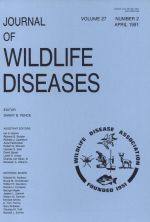Prevalence, intensity and pathogenesis of Lernaea cyprinacea (anchorworm) in stocked rainbow trout (Oncorhynchus mykiss) fingerlings were monitored annually for 4 yr (1981 to 1984) in East Canyon Reservoir, Utah (USA). Anchorworms were first detected in midsummer each year and were most abundant in the fall. The mean parasite intensity was highest in October 1982 (19 anchorworms per fish); in other years, maximum density was 7 to 9. The dorsal and caudal areas of the fish were the most heavily parasitized. The histological response to parasite attachment included an infectious granuloma similar to that reported in other fish hosts. Bacteria were not found in the kidneys of fish before stocking, but afterward bacteria that were presumptively identified as belonging to the genus Aeromonas, were found in the kidneys of up to 45% of the parasitized fish. Most (94%) anglers noticed the anchorworms, but few (8%) discarded parasitized fish. Some 28% used special cleaning techniques to prepare fish but 49% did nothing special to clean them. Lernaeosis probably had little effect on the fishery management goals for the reservoir.
How to translate text using browser tools
1 April 1991
EFFECT OF LERNAEA CYPRINACEA (CRUSTACEA: COPEPODA) ON STOCKED RAINBOW TROUT (ONCORHYNCHUS MYKISS)
Charles R. Berry,
George J. Babey,
Terry Shrader

Journal of Wildlife Diseases
Vol. 27 • No. 2
April 1991
Vol. 27 • No. 2
April 1991
Anchorworm
Copepoda
histopathology
Lernaea cyprinacea
Oncorhynchus mykiss
parasite
Rainbow Trout




